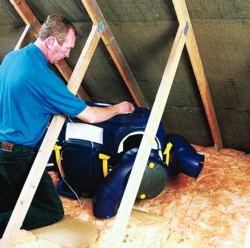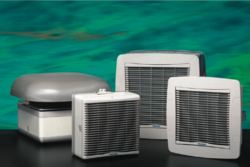Meeting ventilation requirements efficiently

Energy-efficient whole-house ventilation can be achieved using Vent-Axia’s Air Minder, which incorporates heat recovery.
PAUL KILBURN finds that the new Building Regulations provide welcome guidance on providing energy-efficient ventilation.In the relentless drive for greater energy efficiency in buildings, the latest editions of Building Regulations Documents F and L are having a real effect on the choice of heating and ventilating products. Planning applications for all new and some existing buildings now have to demonstrate compliance with the new requirements in these regulations..
Why the changes? By acknowledging the need for adequate ventilation and specifying ventilation rates for the various occupied spaces within buildings, the original Document F on means of ventilation was an important step on the road to a healthier indoor environment. However, it only prescribed minimum standards, and it was all too easy to get lost in the ‘alternative approaches’. What is good about the new Document F on means of ventilation is that it takes a performance-based approach and encourages best practice. Document F now also addresses how to improve indoor air quality by removing and preventing the ingress of gaseous and particulate pollutants,in addition to its original focus on controlling condensation.
More straightforward Each ventilation method is brought into the main body of the document, so continuous mechanical extract, single-room heat recovery and whole-house continuous mechanical supply and extract with heat-recovery feature alongside background ventilators, intermittent extract fans and passive stack ventilation'. All have their place as potentially acceptable solutions, depending on the application. The design parameters, in relation to the number and type of fans, floor areas, siting of equipment and, even, maintenance access, are all explicitly defined for each of the specified systems. It is now much easier to work out what is needed for a particular project and evaluate product choices in terms of overall cost, system performance and ongoing ease of maintenance. There is also clear reference to the requirements of Document L (Conservation of fuel and power) and an important shift in Document F towards energy-efficient ventilation. This in turn points us towards improving SAP ratings (Standard Assessment Procedure for dwellings) with heat-recovery devices, efficient types of fan motor and/or energy-saving control devices in ventilation systems. It shows the joined-up thinking now underlying the Government's SAP for the energy rating of buildings, Document F and Document L. SAP 2006 represents a 20% improvement in energy efficiency over SAP 2002. The new documents are undoubtedly a strong endorsement for the work of leading ventilation manufacturers in establishing fan-drive efficiency, precise controllability and heat recovery as key characteristics of their product ranges. They also point the way ahead in ventilation technology. For example, the LoWatt DC motors used by Vent-Axia can more than halve electrical power consumption and confer precise fan-speed control, ‘intelligent’ electronic controls which minimise ventilation extraction rates whilst ensuring high indoor air quality. Also, heat-recovery systems can recover as much as 90% of the indoor warmth that would otherwise be lost through essential ventilation.
As-installed performance Another significant change relates to the ‘as-installed’ airflow performance of ventilation equipment. It has long been a bone of contention that solutions featuring minimum-spec/minimum cost fans have not been up to the job, despite test performance data suggesting their suitability.

Energy-efficient fan motors, such as those in Vent-Axia’s Lowatt TS range, help reduce the energy required to meet ventilation standards.
Now Document F calls for airflow performance to be tested to a standard that is more relevant to the actual conditions of use. The recently published suite of EN 13141 standards has been referenced, which gives a closer assessment of true volumetric performance of ventilation products in real installations.
The pay-off Far from creating an administrative overload for H&V manufacturers and electrical installers, the new Documents F and L are doing a great deal to clarify ventilation and heating requirements. Previously, Document L called for the best energy-efficient solutions, but Document F did not offer them. Now Document F is filling the gap by giving developers, specifiers and installation contractors practical choices for ventilation and energy conservation. It all adds up to best practice and better choices for installers and gives true scope for value-added projects in an increasingly competitive and energy-aware marketplace.
Paul Kilburn is group commercial with Vent-Axia Ltd, Fleming Way, Crawley, West Sussex RH10 9YX.
Related links:




